Analysis of Hanjin Shipping Bankruptcy and Supply Chain Challenges
VerifiedAdded on 2023/01/19
|11
|3916
|55
Report
AI Summary
This report presents a detailed analysis of the Hanjin Shipping bankruptcy and its significant implications for global supply chain management. The introduction provides an overview of supply chain management and its importance, followed by a company overview of Hanjin Shipping, detailing its position as a major container line before its bankruptcy in 2017. The case study explores the challenges faced by supply chain managers due to the bankruptcy, including issues with shippers and transport alternatives. The report delves into the core concepts of supply chain management, highlighting the role of logistics and its relation to the supply chain. It discusses the risks inherent in supply chain management, such as planning failures, communication breakdowns, and external factors like extreme weather. Finally, the report offers recommendations for improvement, emphasizing the need for effective risk management and robust contingency plans to mitigate the impact of such events on the global supply chain. The report underscores the critical need for integrated and resilient supply chain strategies within the shipping industry.
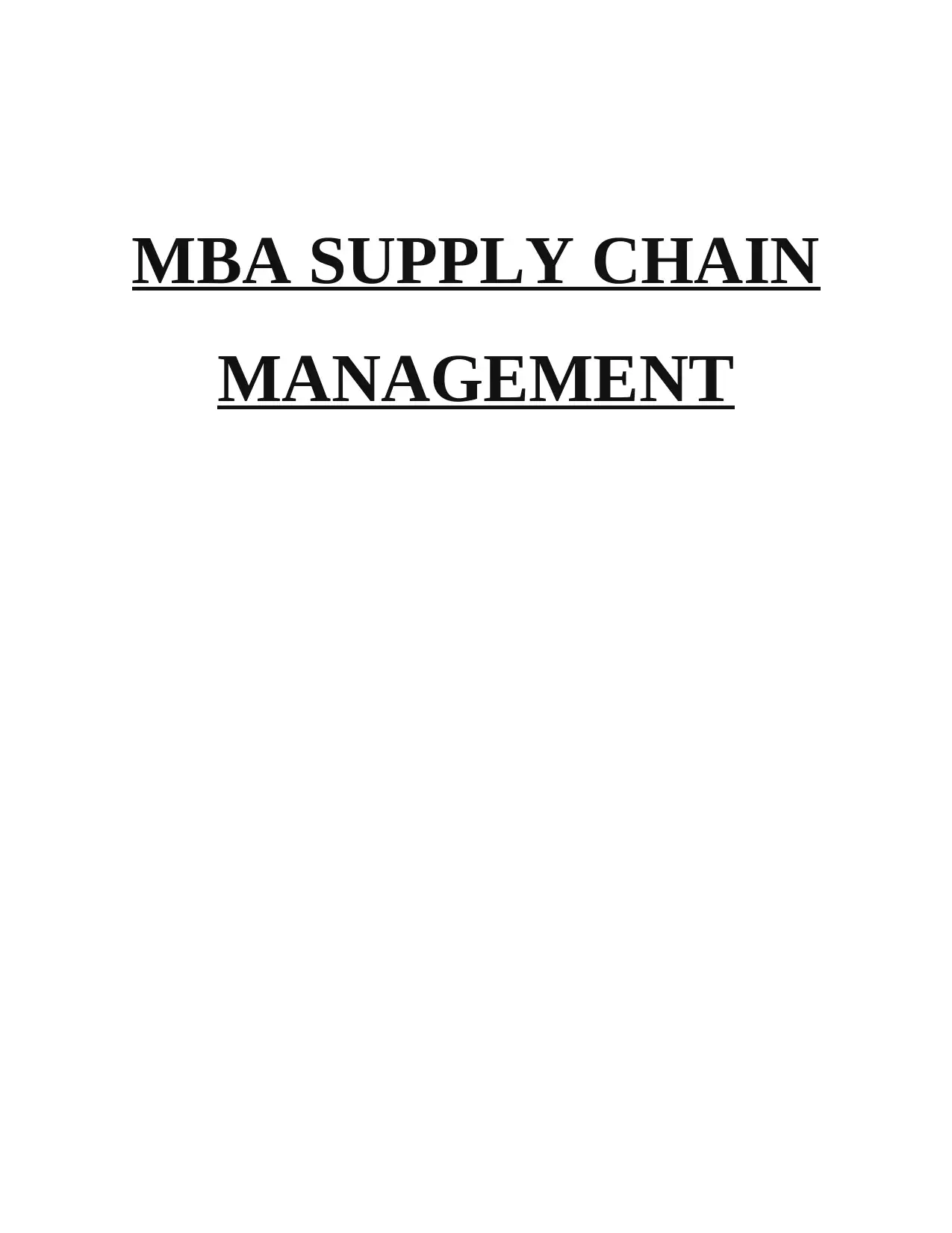
MBA SUPPLY CHAIN
MANAGEMENT
MANAGEMENT
Paraphrase This Document
Need a fresh take? Get an instant paraphrase of this document with our AI Paraphraser
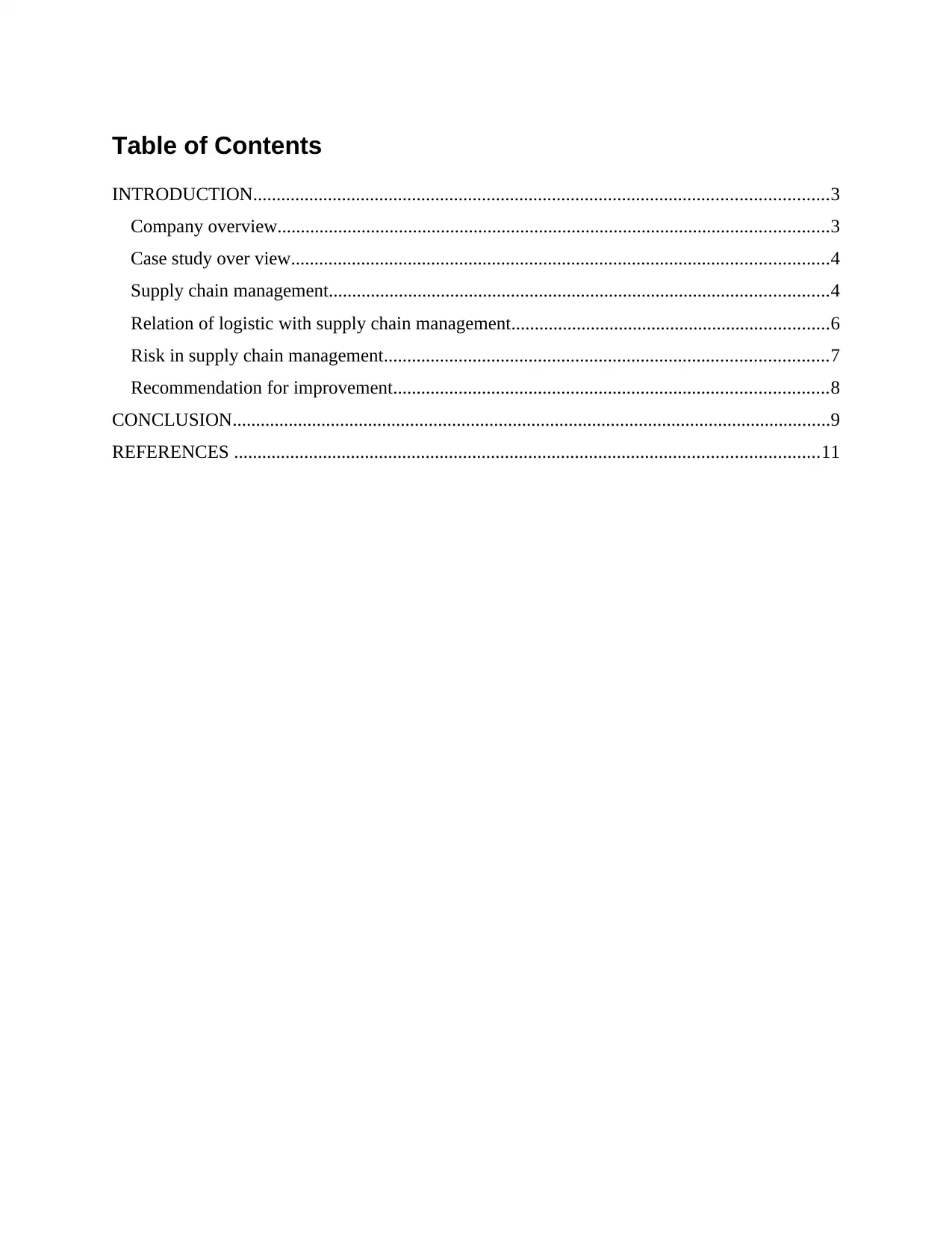
Table of Contents
INTRODUCTION...........................................................................................................................3
Company overview......................................................................................................................3
Case study over view...................................................................................................................4
Supply chain management...........................................................................................................4
Relation of logistic with supply chain management....................................................................6
Risk in supply chain management...............................................................................................7
Recommendation for improvement.............................................................................................8
CONCLUSION................................................................................................................................9
REFERENCES .............................................................................................................................11
INTRODUCTION...........................................................................................................................3
Company overview......................................................................................................................3
Case study over view...................................................................................................................4
Supply chain management...........................................................................................................4
Relation of logistic with supply chain management....................................................................6
Risk in supply chain management...............................................................................................7
Recommendation for improvement.............................................................................................8
CONCLUSION................................................................................................................................9
REFERENCES .............................................................................................................................11
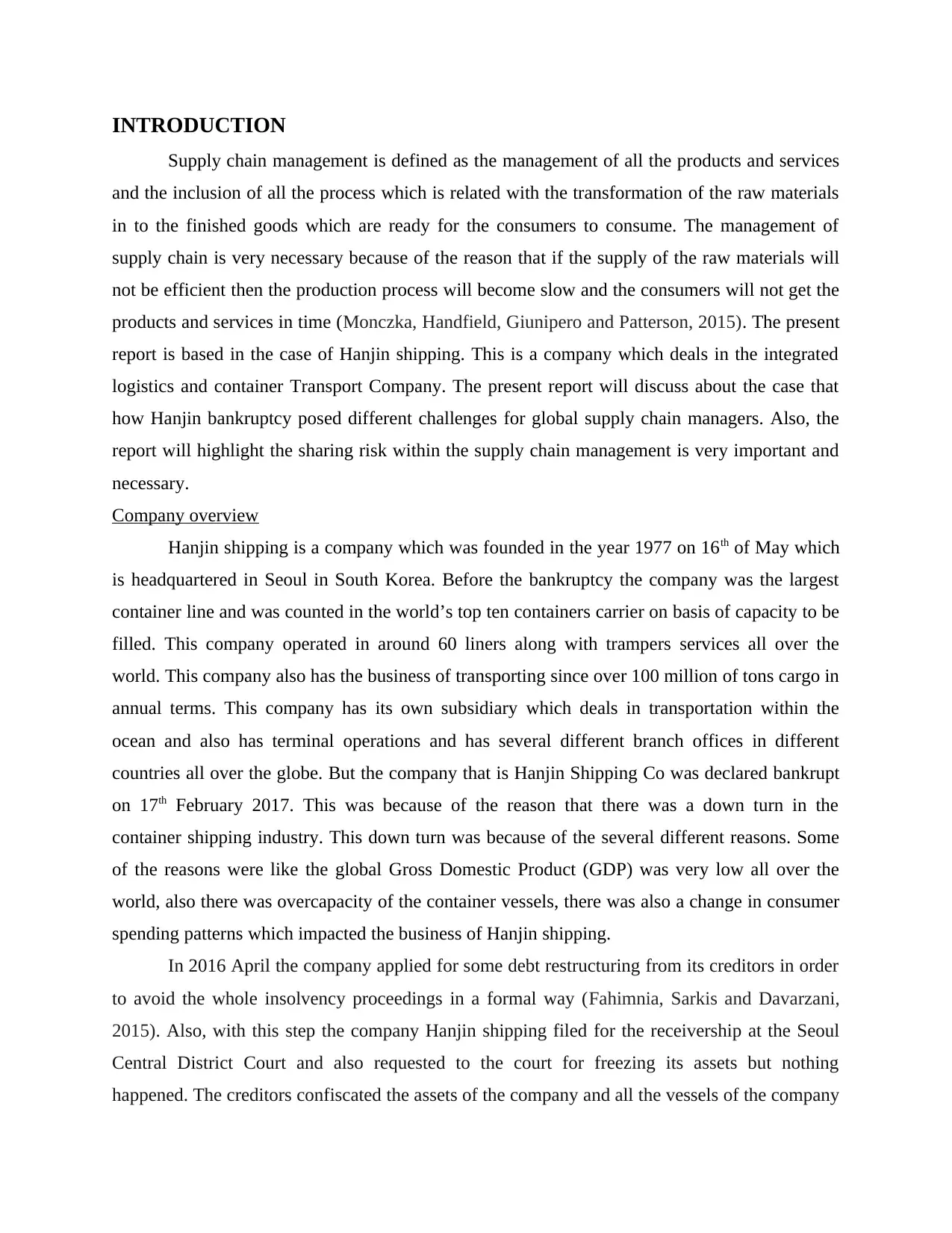
INTRODUCTION
Supply chain management is defined as the management of all the products and services
and the inclusion of all the process which is related with the transformation of the raw materials
in to the finished goods which are ready for the consumers to consume. The management of
supply chain is very necessary because of the reason that if the supply of the raw materials will
not be efficient then the production process will become slow and the consumers will not get the
products and services in time (Monczka, Handfield, Giunipero and Patterson, 2015). The present
report is based in the case of Hanjin shipping. This is a company which deals in the integrated
logistics and container Transport Company. The present report will discuss about the case that
how Hanjin bankruptcy posed different challenges for global supply chain managers. Also, the
report will highlight the sharing risk within the supply chain management is very important and
necessary.
Company overview
Hanjin shipping is a company which was founded in the year 1977 on 16th of May which
is headquartered in Seoul in South Korea. Before the bankruptcy the company was the largest
container line and was counted in the world’s top ten containers carrier on basis of capacity to be
filled. This company operated in around 60 liners along with trampers services all over the
world. This company also has the business of transporting since over 100 million of tons cargo in
annual terms. This company has its own subsidiary which deals in transportation within the
ocean and also has terminal operations and has several different branch offices in different
countries all over the globe. But the company that is Hanjin Shipping Co was declared bankrupt
on 17th February 2017. This was because of the reason that there was a down turn in the
container shipping industry. This down turn was because of the several different reasons. Some
of the reasons were like the global Gross Domestic Product (GDP) was very low all over the
world, also there was overcapacity of the container vessels, there was also a change in consumer
spending patterns which impacted the business of Hanjin shipping.
In 2016 April the company applied for some debt restructuring from its creditors in order
to avoid the whole insolvency proceedings in a formal way (Fahimnia, Sarkis and Davarzani,
2015). Also, with this step the company Hanjin shipping filed for the receivership at the Seoul
Central District Court and also requested to the court for freezing its assets but nothing
happened. The creditors confiscated the assets of the company and all the vessels of the company
Supply chain management is defined as the management of all the products and services
and the inclusion of all the process which is related with the transformation of the raw materials
in to the finished goods which are ready for the consumers to consume. The management of
supply chain is very necessary because of the reason that if the supply of the raw materials will
not be efficient then the production process will become slow and the consumers will not get the
products and services in time (Monczka, Handfield, Giunipero and Patterson, 2015). The present
report is based in the case of Hanjin shipping. This is a company which deals in the integrated
logistics and container Transport Company. The present report will discuss about the case that
how Hanjin bankruptcy posed different challenges for global supply chain managers. Also, the
report will highlight the sharing risk within the supply chain management is very important and
necessary.
Company overview
Hanjin shipping is a company which was founded in the year 1977 on 16th of May which
is headquartered in Seoul in South Korea. Before the bankruptcy the company was the largest
container line and was counted in the world’s top ten containers carrier on basis of capacity to be
filled. This company operated in around 60 liners along with trampers services all over the
world. This company also has the business of transporting since over 100 million of tons cargo in
annual terms. This company has its own subsidiary which deals in transportation within the
ocean and also has terminal operations and has several different branch offices in different
countries all over the globe. But the company that is Hanjin Shipping Co was declared bankrupt
on 17th February 2017. This was because of the reason that there was a down turn in the
container shipping industry. This down turn was because of the several different reasons. Some
of the reasons were like the global Gross Domestic Product (GDP) was very low all over the
world, also there was overcapacity of the container vessels, there was also a change in consumer
spending patterns which impacted the business of Hanjin shipping.
In 2016 April the company applied for some debt restructuring from its creditors in order
to avoid the whole insolvency proceedings in a formal way (Fahimnia, Sarkis and Davarzani,
2015). Also, with this step the company Hanjin shipping filed for the receivership at the Seoul
Central District Court and also requested to the court for freezing its assets but nothing
happened. The creditors confiscated the assets of the company and all the vessels of the company
⊘ This is a preview!⊘
Do you want full access?
Subscribe today to unlock all pages.

Trusted by 1+ million students worldwide
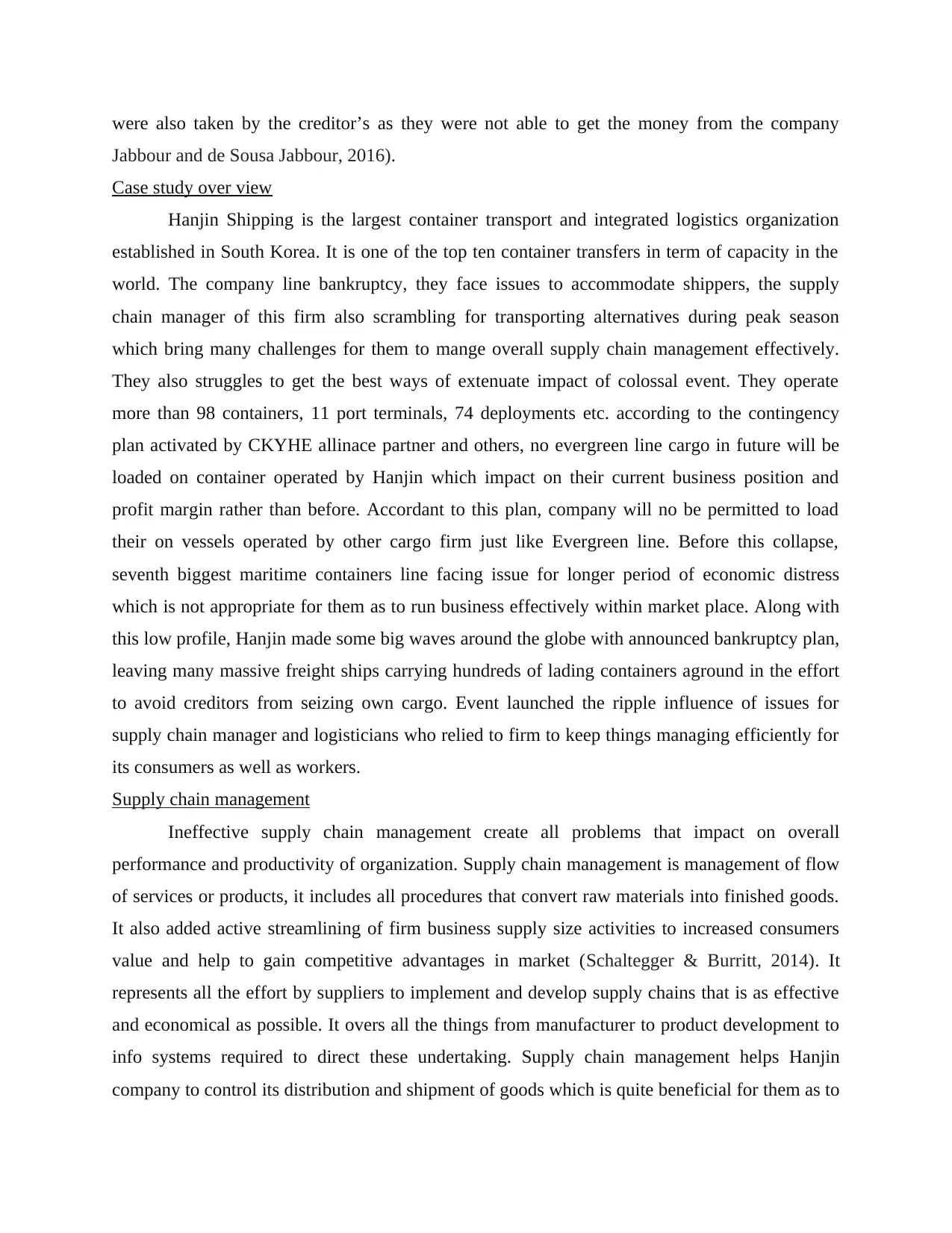
were also taken by the creditor’s as they were not able to get the money from the company
Jabbour and de Sousa Jabbour, 2016).
Case study over view
Hanjin Shipping is the largest container transport and integrated logistics organization
established in South Korea. It is one of the top ten container transfers in term of capacity in the
world. The company line bankruptcy, they face issues to accommodate shippers, the supply
chain manager of this firm also scrambling for transporting alternatives during peak season
which bring many challenges for them to mange overall supply chain management effectively.
They also struggles to get the best ways of extenuate impact of colossal event. They operate
more than 98 containers, 11 port terminals, 74 deployments etc. according to the contingency
plan activated by CKYHE allinace partner and others, no evergreen line cargo in future will be
loaded on container operated by Hanjin which impact on their current business position and
profit margin rather than before. Accordant to this plan, company will no be permitted to load
their on vessels operated by other cargo firm just like Evergreen line. Before this collapse,
seventh biggest maritime containers line facing issue for longer period of economic distress
which is not appropriate for them as to run business effectively within market place. Along with
this low profile, Hanjin made some big waves around the globe with announced bankruptcy plan,
leaving many massive freight ships carrying hundreds of lading containers aground in the effort
to avoid creditors from seizing own cargo. Event launched the ripple influence of issues for
supply chain manager and logisticians who relied to firm to keep things managing efficiently for
its consumers as well as workers.
Supply chain management
Ineffective supply chain management create all problems that impact on overall
performance and productivity of organization. Supply chain management is management of flow
of services or products, it includes all procedures that convert raw materials into finished goods.
It also added active streamlining of firm business supply size activities to increased consumers
value and help to gain competitive advantages in market (Schaltegger & Burritt, 2014). It
represents all the effort by suppliers to implement and develop supply chains that is as effective
and economical as possible. It overs all the things from manufacturer to product development to
info systems required to direct these undertaking. Supply chain management helps Hanjin
company to control its distribution and shipment of goods which is quite beneficial for them as to
Jabbour and de Sousa Jabbour, 2016).
Case study over view
Hanjin Shipping is the largest container transport and integrated logistics organization
established in South Korea. It is one of the top ten container transfers in term of capacity in the
world. The company line bankruptcy, they face issues to accommodate shippers, the supply
chain manager of this firm also scrambling for transporting alternatives during peak season
which bring many challenges for them to mange overall supply chain management effectively.
They also struggles to get the best ways of extenuate impact of colossal event. They operate
more than 98 containers, 11 port terminals, 74 deployments etc. according to the contingency
plan activated by CKYHE allinace partner and others, no evergreen line cargo in future will be
loaded on container operated by Hanjin which impact on their current business position and
profit margin rather than before. Accordant to this plan, company will no be permitted to load
their on vessels operated by other cargo firm just like Evergreen line. Before this collapse,
seventh biggest maritime containers line facing issue for longer period of economic distress
which is not appropriate for them as to run business effectively within market place. Along with
this low profile, Hanjin made some big waves around the globe with announced bankruptcy plan,
leaving many massive freight ships carrying hundreds of lading containers aground in the effort
to avoid creditors from seizing own cargo. Event launched the ripple influence of issues for
supply chain manager and logisticians who relied to firm to keep things managing efficiently for
its consumers as well as workers.
Supply chain management
Ineffective supply chain management create all problems that impact on overall
performance and productivity of organization. Supply chain management is management of flow
of services or products, it includes all procedures that convert raw materials into finished goods.
It also added active streamlining of firm business supply size activities to increased consumers
value and help to gain competitive advantages in market (Schaltegger & Burritt, 2014). It
represents all the effort by suppliers to implement and develop supply chains that is as effective
and economical as possible. It overs all the things from manufacturer to product development to
info systems required to direct these undertaking. Supply chain management helps Hanjin
company to control its distribution and shipment of goods which is quite beneficial for them as to
Paraphrase This Document
Need a fresh take? Get an instant paraphrase of this document with our AI Paraphraser
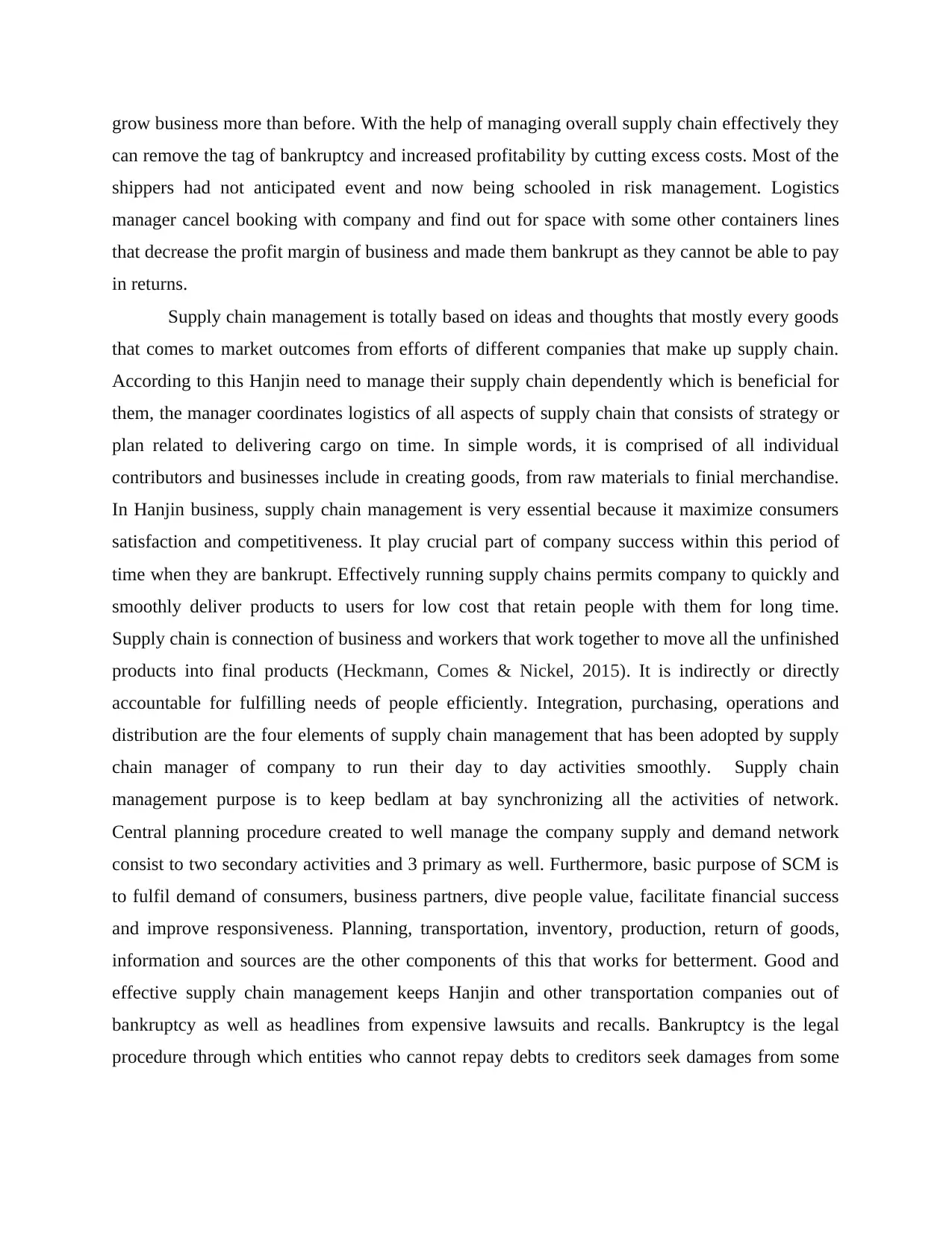
grow business more than before. With the help of managing overall supply chain effectively they
can remove the tag of bankruptcy and increased profitability by cutting excess costs. Most of the
shippers had not anticipated event and now being schooled in risk management. Logistics
manager cancel booking with company and find out for space with some other containers lines
that decrease the profit margin of business and made them bankrupt as they cannot be able to pay
in returns.
Supply chain management is totally based on ideas and thoughts that mostly every goods
that comes to market outcomes from efforts of different companies that make up supply chain.
According to this Hanjin need to manage their supply chain dependently which is beneficial for
them, the manager coordinates logistics of all aspects of supply chain that consists of strategy or
plan related to delivering cargo on time. In simple words, it is comprised of all individual
contributors and businesses include in creating goods, from raw materials to finial merchandise.
In Hanjin business, supply chain management is very essential because it maximize consumers
satisfaction and competitiveness. It play crucial part of company success within this period of
time when they are bankrupt. Effectively running supply chains permits company to quickly and
smoothly deliver products to users for low cost that retain people with them for long time.
Supply chain is connection of business and workers that work together to move all the unfinished
products into final products (Heckmann, Comes & Nickel, 2015). It is indirectly or directly
accountable for fulfilling needs of people efficiently. Integration, purchasing, operations and
distribution are the four elements of supply chain management that has been adopted by supply
chain manager of company to run their day to day activities smoothly. Supply chain
management purpose is to keep bedlam at bay synchronizing all the activities of network.
Central planning procedure created to well manage the company supply and demand network
consist to two secondary activities and 3 primary as well. Furthermore, basic purpose of SCM is
to fulfil demand of consumers, business partners, dive people value, facilitate financial success
and improve responsiveness. Planning, transportation, inventory, production, return of goods,
information and sources are the other components of this that works for betterment. Good and
effective supply chain management keeps Hanjin and other transportation companies out of
bankruptcy as well as headlines from expensive lawsuits and recalls. Bankruptcy is the legal
procedure through which entities who cannot repay debts to creditors seek damages from some
can remove the tag of bankruptcy and increased profitability by cutting excess costs. Most of the
shippers had not anticipated event and now being schooled in risk management. Logistics
manager cancel booking with company and find out for space with some other containers lines
that decrease the profit margin of business and made them bankrupt as they cannot be able to pay
in returns.
Supply chain management is totally based on ideas and thoughts that mostly every goods
that comes to market outcomes from efforts of different companies that make up supply chain.
According to this Hanjin need to manage their supply chain dependently which is beneficial for
them, the manager coordinates logistics of all aspects of supply chain that consists of strategy or
plan related to delivering cargo on time. In simple words, it is comprised of all individual
contributors and businesses include in creating goods, from raw materials to finial merchandise.
In Hanjin business, supply chain management is very essential because it maximize consumers
satisfaction and competitiveness. It play crucial part of company success within this period of
time when they are bankrupt. Effectively running supply chains permits company to quickly and
smoothly deliver products to users for low cost that retain people with them for long time.
Supply chain is connection of business and workers that work together to move all the unfinished
products into final products (Heckmann, Comes & Nickel, 2015). It is indirectly or directly
accountable for fulfilling needs of people efficiently. Integration, purchasing, operations and
distribution are the four elements of supply chain management that has been adopted by supply
chain manager of company to run their day to day activities smoothly. Supply chain
management purpose is to keep bedlam at bay synchronizing all the activities of network.
Central planning procedure created to well manage the company supply and demand network
consist to two secondary activities and 3 primary as well. Furthermore, basic purpose of SCM is
to fulfil demand of consumers, business partners, dive people value, facilitate financial success
and improve responsiveness. Planning, transportation, inventory, production, return of goods,
information and sources are the other components of this that works for betterment. Good and
effective supply chain management keeps Hanjin and other transportation companies out of
bankruptcy as well as headlines from expensive lawsuits and recalls. Bankruptcy is the legal
procedure through which entities who cannot repay debts to creditors seek damages from some
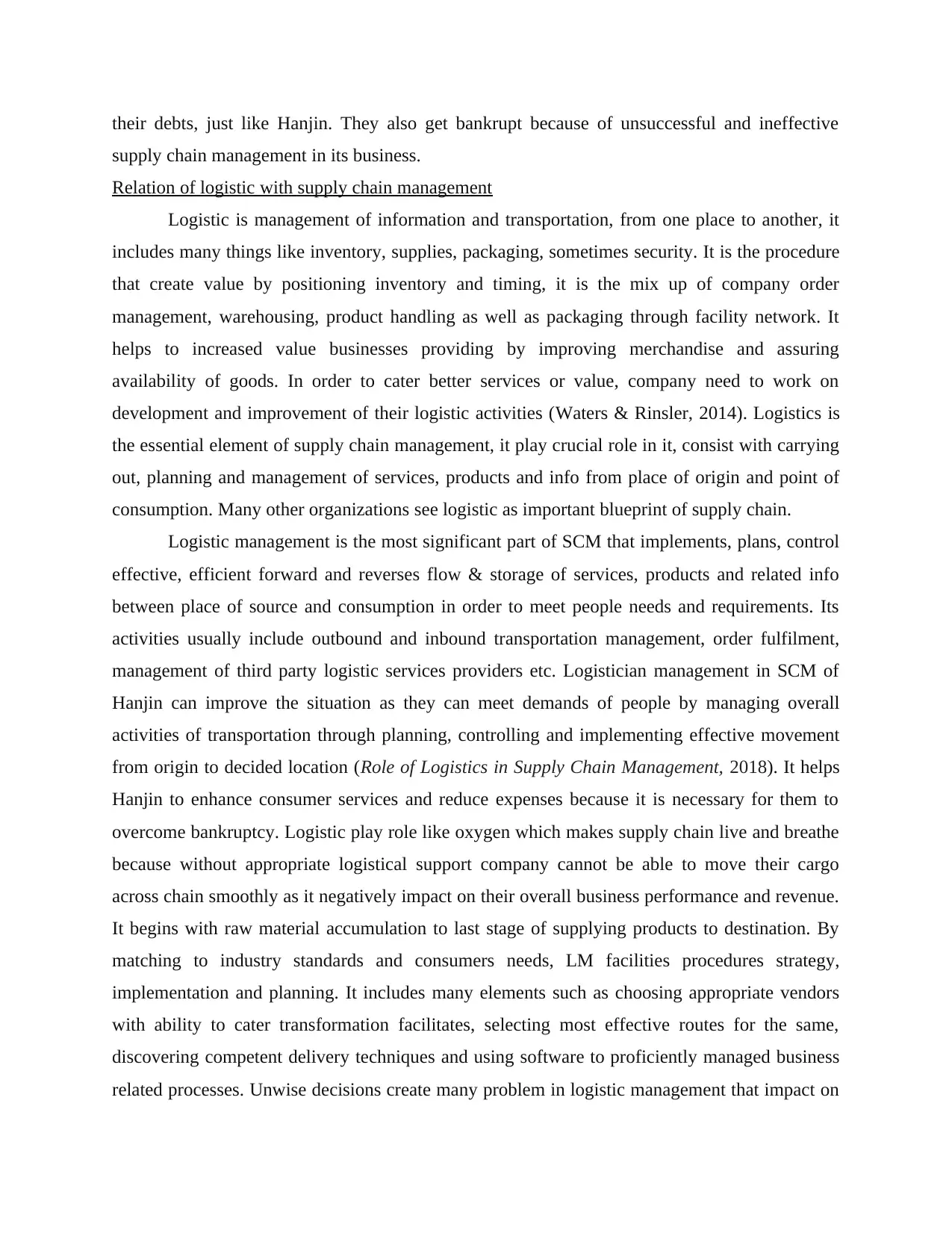
their debts, just like Hanjin. They also get bankrupt because of unsuccessful and ineffective
supply chain management in its business.
Relation of logistic with supply chain management
Logistic is management of information and transportation, from one place to another, it
includes many things like inventory, supplies, packaging, sometimes security. It is the procedure
that create value by positioning inventory and timing, it is the mix up of company order
management, warehousing, product handling as well as packaging through facility network. It
helps to increased value businesses providing by improving merchandise and assuring
availability of goods. In order to cater better services or value, company need to work on
development and improvement of their logistic activities (Waters & Rinsler, 2014). Logistics is
the essential element of supply chain management, it play crucial role in it, consist with carrying
out, planning and management of services, products and info from place of origin and point of
consumption. Many other organizations see logistic as important blueprint of supply chain.
Logistic management is the most significant part of SCM that implements, plans, control
effective, efficient forward and reverses flow & storage of services, products and related info
between place of source and consumption in order to meet people needs and requirements. Its
activities usually include outbound and inbound transportation management, order fulfilment,
management of third party logistic services providers etc. Logistician management in SCM of
Hanjin can improve the situation as they can meet demands of people by managing overall
activities of transportation through planning, controlling and implementing effective movement
from origin to decided location (Role of Logistics in Supply Chain Management, 2018). It helps
Hanjin to enhance consumer services and reduce expenses because it is necessary for them to
overcome bankruptcy. Logistic play role like oxygen which makes supply chain live and breathe
because without appropriate logistical support company cannot be able to move their cargo
across chain smoothly as it negatively impact on their overall business performance and revenue.
It begins with raw material accumulation to last stage of supplying products to destination. By
matching to industry standards and consumers needs, LM facilities procedures strategy,
implementation and planning. It includes many elements such as choosing appropriate vendors
with ability to cater transformation facilitates, selecting most effective routes for the same,
discovering competent delivery techniques and using software to proficiently managed business
related processes. Unwise decisions create many problem in logistic management that impact on
supply chain management in its business.
Relation of logistic with supply chain management
Logistic is management of information and transportation, from one place to another, it
includes many things like inventory, supplies, packaging, sometimes security. It is the procedure
that create value by positioning inventory and timing, it is the mix up of company order
management, warehousing, product handling as well as packaging through facility network. It
helps to increased value businesses providing by improving merchandise and assuring
availability of goods. In order to cater better services or value, company need to work on
development and improvement of their logistic activities (Waters & Rinsler, 2014). Logistics is
the essential element of supply chain management, it play crucial role in it, consist with carrying
out, planning and management of services, products and info from place of origin and point of
consumption. Many other organizations see logistic as important blueprint of supply chain.
Logistic management is the most significant part of SCM that implements, plans, control
effective, efficient forward and reverses flow & storage of services, products and related info
between place of source and consumption in order to meet people needs and requirements. Its
activities usually include outbound and inbound transportation management, order fulfilment,
management of third party logistic services providers etc. Logistician management in SCM of
Hanjin can improve the situation as they can meet demands of people by managing overall
activities of transportation through planning, controlling and implementing effective movement
from origin to decided location (Role of Logistics in Supply Chain Management, 2018). It helps
Hanjin to enhance consumer services and reduce expenses because it is necessary for them to
overcome bankruptcy. Logistic play role like oxygen which makes supply chain live and breathe
because without appropriate logistical support company cannot be able to move their cargo
across chain smoothly as it negatively impact on their overall business performance and revenue.
It begins with raw material accumulation to last stage of supplying products to destination. By
matching to industry standards and consumers needs, LM facilities procedures strategy,
implementation and planning. It includes many elements such as choosing appropriate vendors
with ability to cater transformation facilitates, selecting most effective routes for the same,
discovering competent delivery techniques and using software to proficiently managed business
related processes. Unwise decisions create many problem in logistic management that impact on
⊘ This is a preview!⊘
Do you want full access?
Subscribe today to unlock all pages.

Trusted by 1+ million students worldwide
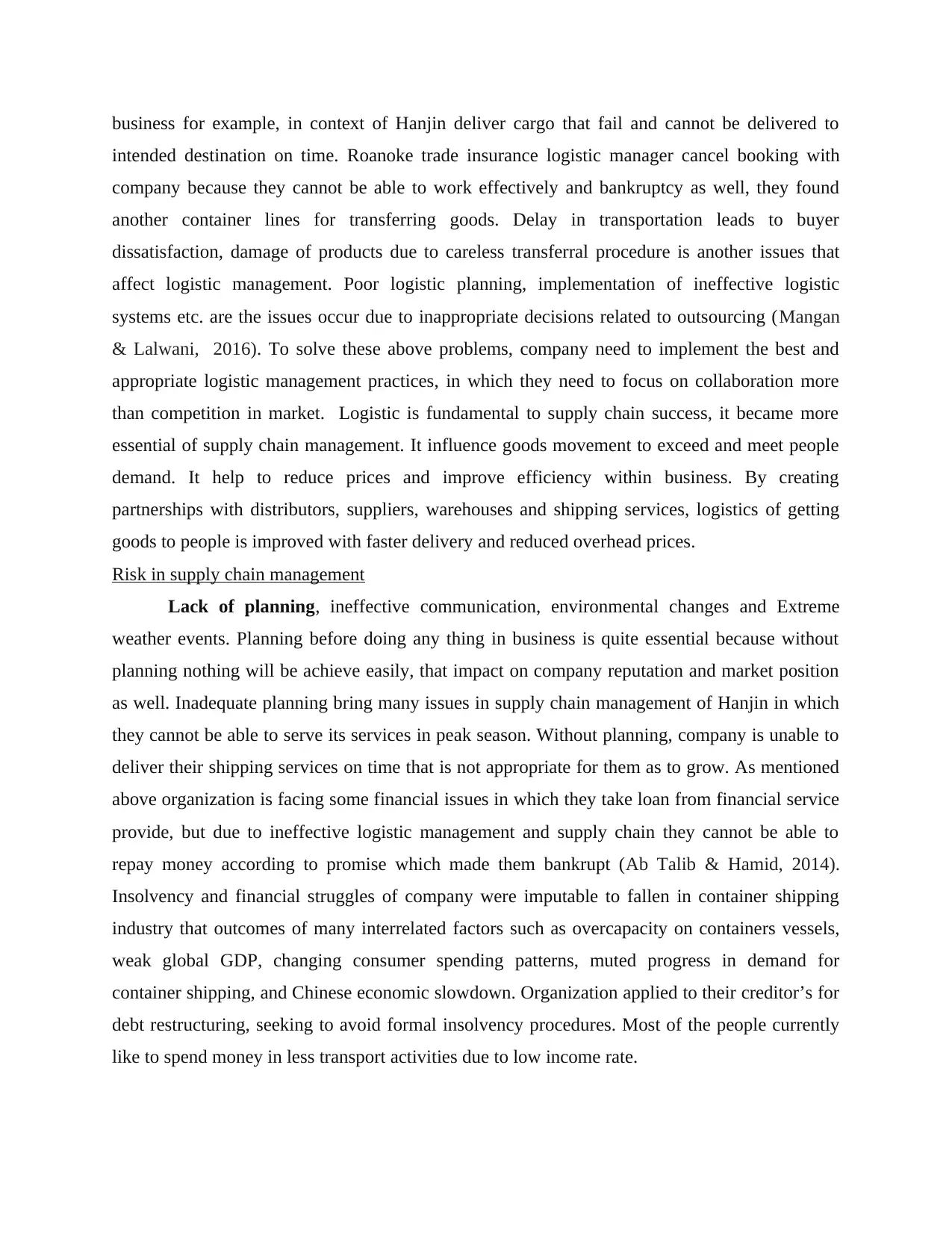
business for example, in context of Hanjin deliver cargo that fail and cannot be delivered to
intended destination on time. Roanoke trade insurance logistic manager cancel booking with
company because they cannot be able to work effectively and bankruptcy as well, they found
another container lines for transferring goods. Delay in transportation leads to buyer
dissatisfaction, damage of products due to careless transferral procedure is another issues that
affect logistic management. Poor logistic planning, implementation of ineffective logistic
systems etc. are the issues occur due to inappropriate decisions related to outsourcing (Mangan
& Lalwani, 2016). To solve these above problems, company need to implement the best and
appropriate logistic management practices, in which they need to focus on collaboration more
than competition in market. Logistic is fundamental to supply chain success, it became more
essential of supply chain management. It influence goods movement to exceed and meet people
demand. It help to reduce prices and improve efficiency within business. By creating
partnerships with distributors, suppliers, warehouses and shipping services, logistics of getting
goods to people is improved with faster delivery and reduced overhead prices.
Risk in supply chain management
Lack of planning, ineffective communication, environmental changes and Extreme
weather events. Planning before doing any thing in business is quite essential because without
planning nothing will be achieve easily, that impact on company reputation and market position
as well. Inadequate planning bring many issues in supply chain management of Hanjin in which
they cannot be able to serve its services in peak season. Without planning, company is unable to
deliver their shipping services on time that is not appropriate for them as to grow. As mentioned
above organization is facing some financial issues in which they take loan from financial service
provide, but due to ineffective logistic management and supply chain they cannot be able to
repay money according to promise which made them bankrupt (Ab Talib & Hamid, 2014).
Insolvency and financial struggles of company were imputable to fallen in container shipping
industry that outcomes of many interrelated factors such as overcapacity on containers vessels,
weak global GDP, changing consumer spending patterns, muted progress in demand for
container shipping, and Chinese economic slowdown. Organization applied to their creditor’s for
debt restructuring, seeking to avoid formal insolvency procedures. Most of the people currently
like to spend money in less transport activities due to low income rate.
intended destination on time. Roanoke trade insurance logistic manager cancel booking with
company because they cannot be able to work effectively and bankruptcy as well, they found
another container lines for transferring goods. Delay in transportation leads to buyer
dissatisfaction, damage of products due to careless transferral procedure is another issues that
affect logistic management. Poor logistic planning, implementation of ineffective logistic
systems etc. are the issues occur due to inappropriate decisions related to outsourcing (Mangan
& Lalwani, 2016). To solve these above problems, company need to implement the best and
appropriate logistic management practices, in which they need to focus on collaboration more
than competition in market. Logistic is fundamental to supply chain success, it became more
essential of supply chain management. It influence goods movement to exceed and meet people
demand. It help to reduce prices and improve efficiency within business. By creating
partnerships with distributors, suppliers, warehouses and shipping services, logistics of getting
goods to people is improved with faster delivery and reduced overhead prices.
Risk in supply chain management
Lack of planning, ineffective communication, environmental changes and Extreme
weather events. Planning before doing any thing in business is quite essential because without
planning nothing will be achieve easily, that impact on company reputation and market position
as well. Inadequate planning bring many issues in supply chain management of Hanjin in which
they cannot be able to serve its services in peak season. Without planning, company is unable to
deliver their shipping services on time that is not appropriate for them as to grow. As mentioned
above organization is facing some financial issues in which they take loan from financial service
provide, but due to ineffective logistic management and supply chain they cannot be able to
repay money according to promise which made them bankrupt (Ab Talib & Hamid, 2014).
Insolvency and financial struggles of company were imputable to fallen in container shipping
industry that outcomes of many interrelated factors such as overcapacity on containers vessels,
weak global GDP, changing consumer spending patterns, muted progress in demand for
container shipping, and Chinese economic slowdown. Organization applied to their creditor’s for
debt restructuring, seeking to avoid formal insolvency procedures. Most of the people currently
like to spend money in less transport activities due to low income rate.
Paraphrase This Document
Need a fresh take? Get an instant paraphrase of this document with our AI Paraphraser
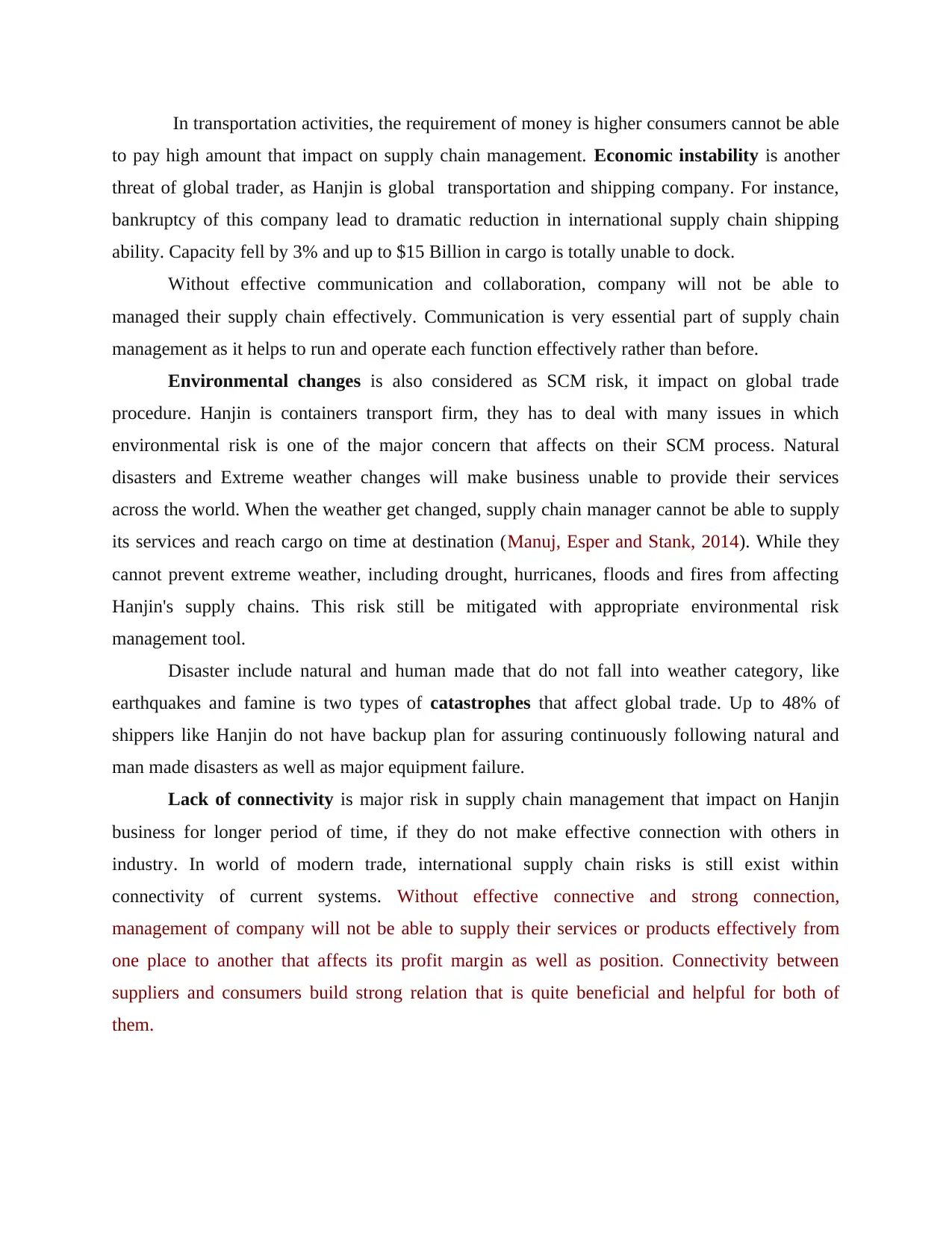
In transportation activities, the requirement of money is higher consumers cannot be able
to pay high amount that impact on supply chain management. Economic instability is another
threat of global trader, as Hanjin is global transportation and shipping company. For instance,
bankruptcy of this company lead to dramatic reduction in international supply chain shipping
ability. Capacity fell by 3% and up to $15 Billion in cargo is totally unable to dock.
Without effective communication and collaboration, company will not be able to
managed their supply chain effectively. Communication is very essential part of supply chain
management as it helps to run and operate each function effectively rather than before.
Environmental changes is also considered as SCM risk, it impact on global trade
procedure. Hanjin is containers transport firm, they has to deal with many issues in which
environmental risk is one of the major concern that affects on their SCM process. Natural
disasters and Extreme weather changes will make business unable to provide their services
across the world. When the weather get changed, supply chain manager cannot be able to supply
its services and reach cargo on time at destination (Manuj, Esper and Stank, 2014). While they
cannot prevent extreme weather, including drought, hurricanes, floods and fires from affecting
Hanjin's supply chains. This risk still be mitigated with appropriate environmental risk
management tool.
Disaster include natural and human made that do not fall into weather category, like
earthquakes and famine is two types of catastrophes that affect global trade. Up to 48% of
shippers like Hanjin do not have backup plan for assuring continuously following natural and
man made disasters as well as major equipment failure.
Lack of connectivity is major risk in supply chain management that impact on Hanjin
business for longer period of time, if they do not make effective connection with others in
industry. In world of modern trade, international supply chain risks is still exist within
connectivity of current systems. Without effective connective and strong connection,
management of company will not be able to supply their services or products effectively from
one place to another that affects its profit margin as well as position. Connectivity between
suppliers and consumers build strong relation that is quite beneficial and helpful for both of
them.
to pay high amount that impact on supply chain management. Economic instability is another
threat of global trader, as Hanjin is global transportation and shipping company. For instance,
bankruptcy of this company lead to dramatic reduction in international supply chain shipping
ability. Capacity fell by 3% and up to $15 Billion in cargo is totally unable to dock.
Without effective communication and collaboration, company will not be able to
managed their supply chain effectively. Communication is very essential part of supply chain
management as it helps to run and operate each function effectively rather than before.
Environmental changes is also considered as SCM risk, it impact on global trade
procedure. Hanjin is containers transport firm, they has to deal with many issues in which
environmental risk is one of the major concern that affects on their SCM process. Natural
disasters and Extreme weather changes will make business unable to provide their services
across the world. When the weather get changed, supply chain manager cannot be able to supply
its services and reach cargo on time at destination (Manuj, Esper and Stank, 2014). While they
cannot prevent extreme weather, including drought, hurricanes, floods and fires from affecting
Hanjin's supply chains. This risk still be mitigated with appropriate environmental risk
management tool.
Disaster include natural and human made that do not fall into weather category, like
earthquakes and famine is two types of catastrophes that affect global trade. Up to 48% of
shippers like Hanjin do not have backup plan for assuring continuously following natural and
man made disasters as well as major equipment failure.
Lack of connectivity is major risk in supply chain management that impact on Hanjin
business for longer period of time, if they do not make effective connection with others in
industry. In world of modern trade, international supply chain risks is still exist within
connectivity of current systems. Without effective connective and strong connection,
management of company will not be able to supply their services or products effectively from
one place to another that affects its profit margin as well as position. Connectivity between
suppliers and consumers build strong relation that is quite beneficial and helpful for both of
them.
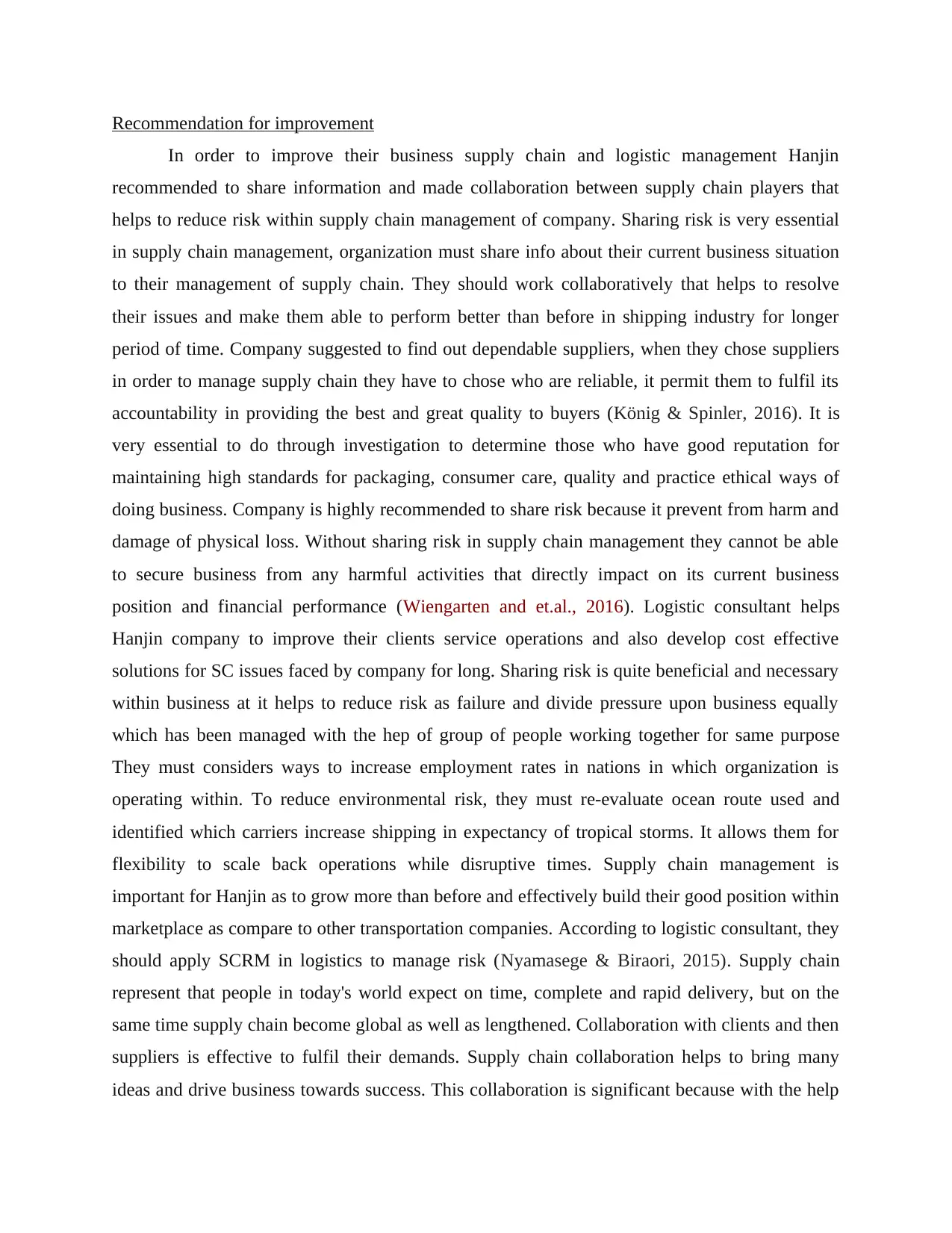
Recommendation for improvement
In order to improve their business supply chain and logistic management Hanjin
recommended to share information and made collaboration between supply chain players that
helps to reduce risk within supply chain management of company. Sharing risk is very essential
in supply chain management, organization must share info about their current business situation
to their management of supply chain. They should work collaboratively that helps to resolve
their issues and make them able to perform better than before in shipping industry for longer
period of time. Company suggested to find out dependable suppliers, when they chose suppliers
in order to manage supply chain they have to chose who are reliable, it permit them to fulfil its
accountability in providing the best and great quality to buyers (König & Spinler, 2016). It is
very essential to do through investigation to determine those who have good reputation for
maintaining high standards for packaging, consumer care, quality and practice ethical ways of
doing business. Company is highly recommended to share risk because it prevent from harm and
damage of physical loss. Without sharing risk in supply chain management they cannot be able
to secure business from any harmful activities that directly impact on its current business
position and financial performance (Wiengarten and et.al., 2016). Logistic consultant helps
Hanjin company to improve their clients service operations and also develop cost effective
solutions for SC issues faced by company for long. Sharing risk is quite beneficial and necessary
within business at it helps to reduce risk as failure and divide pressure upon business equally
which has been managed with the hep of group of people working together for same purpose
They must considers ways to increase employment rates in nations in which organization is
operating within. To reduce environmental risk, they must re-evaluate ocean route used and
identified which carriers increase shipping in expectancy of tropical storms. It allows them for
flexibility to scale back operations while disruptive times. Supply chain management is
important for Hanjin as to grow more than before and effectively build their good position within
marketplace as compare to other transportation companies. According to logistic consultant, they
should apply SCRM in logistics to manage risk (Nyamasege & Biraori, 2015). Supply chain
represent that people in today's world expect on time, complete and rapid delivery, but on the
same time supply chain become global as well as lengthened. Collaboration with clients and then
suppliers is effective to fulfil their demands. Supply chain collaboration helps to bring many
ideas and drive business towards success. This collaboration is significant because with the help
In order to improve their business supply chain and logistic management Hanjin
recommended to share information and made collaboration between supply chain players that
helps to reduce risk within supply chain management of company. Sharing risk is very essential
in supply chain management, organization must share info about their current business situation
to their management of supply chain. They should work collaboratively that helps to resolve
their issues and make them able to perform better than before in shipping industry for longer
period of time. Company suggested to find out dependable suppliers, when they chose suppliers
in order to manage supply chain they have to chose who are reliable, it permit them to fulfil its
accountability in providing the best and great quality to buyers (König & Spinler, 2016). It is
very essential to do through investigation to determine those who have good reputation for
maintaining high standards for packaging, consumer care, quality and practice ethical ways of
doing business. Company is highly recommended to share risk because it prevent from harm and
damage of physical loss. Without sharing risk in supply chain management they cannot be able
to secure business from any harmful activities that directly impact on its current business
position and financial performance (Wiengarten and et.al., 2016). Logistic consultant helps
Hanjin company to improve their clients service operations and also develop cost effective
solutions for SC issues faced by company for long. Sharing risk is quite beneficial and necessary
within business at it helps to reduce risk as failure and divide pressure upon business equally
which has been managed with the hep of group of people working together for same purpose
They must considers ways to increase employment rates in nations in which organization is
operating within. To reduce environmental risk, they must re-evaluate ocean route used and
identified which carriers increase shipping in expectancy of tropical storms. It allows them for
flexibility to scale back operations while disruptive times. Supply chain management is
important for Hanjin as to grow more than before and effectively build their good position within
marketplace as compare to other transportation companies. According to logistic consultant, they
should apply SCRM in logistics to manage risk (Nyamasege & Biraori, 2015). Supply chain
represent that people in today's world expect on time, complete and rapid delivery, but on the
same time supply chain become global as well as lengthened. Collaboration with clients and then
suppliers is effective to fulfil their demands. Supply chain collaboration helps to bring many
ideas and drive business towards success. This collaboration is significant because with the help
⊘ This is a preview!⊘
Do you want full access?
Subscribe today to unlock all pages.

Trusted by 1+ million students worldwide
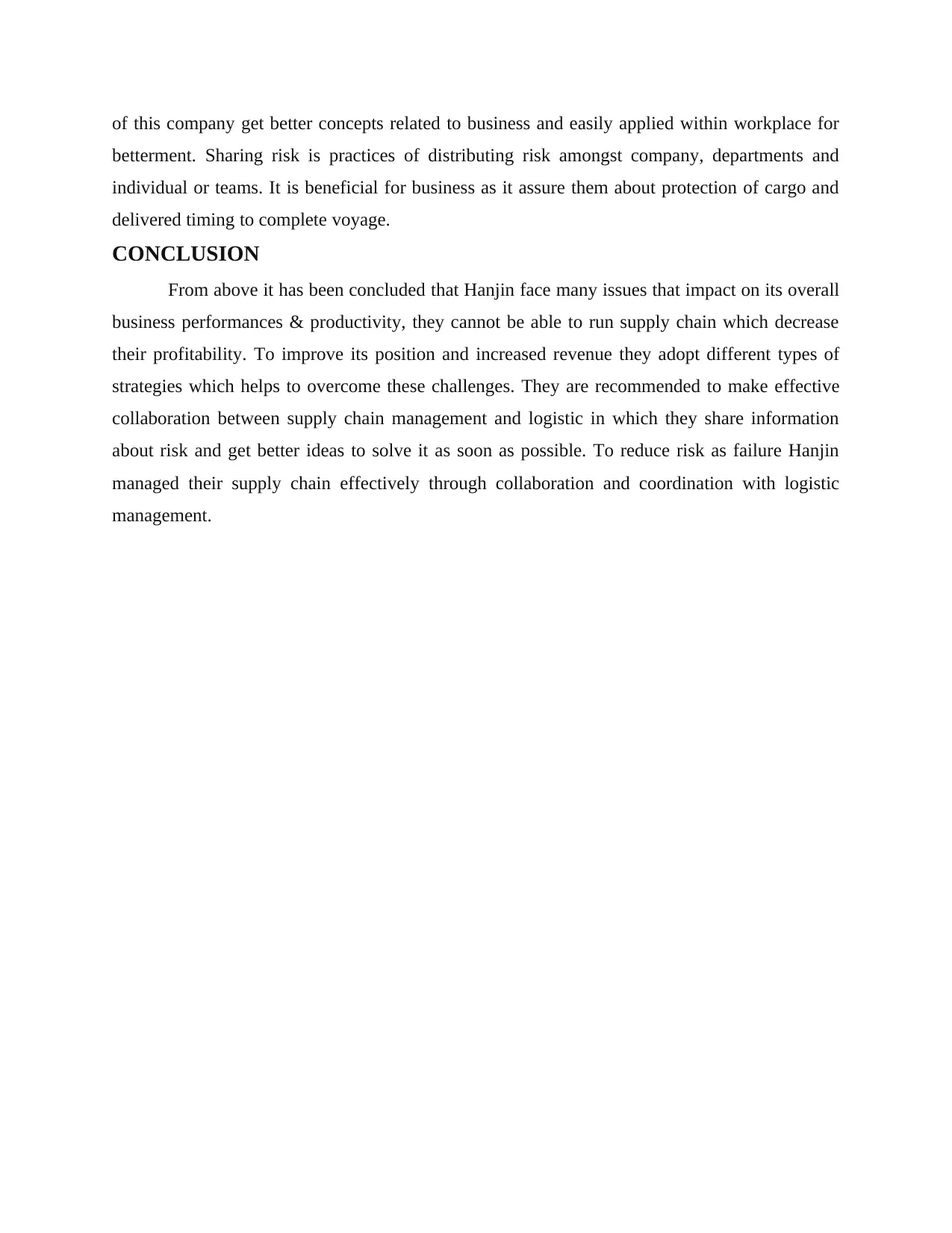
of this company get better concepts related to business and easily applied within workplace for
betterment. Sharing risk is practices of distributing risk amongst company, departments and
individual or teams. It is beneficial for business as it assure them about protection of cargo and
delivered timing to complete voyage.
CONCLUSION
From above it has been concluded that Hanjin face many issues that impact on its overall
business performances & productivity, they cannot be able to run supply chain which decrease
their profitability. To improve its position and increased revenue they adopt different types of
strategies which helps to overcome these challenges. They are recommended to make effective
collaboration between supply chain management and logistic in which they share information
about risk and get better ideas to solve it as soon as possible. To reduce risk as failure Hanjin
managed their supply chain effectively through collaboration and coordination with logistic
management.
betterment. Sharing risk is practices of distributing risk amongst company, departments and
individual or teams. It is beneficial for business as it assure them about protection of cargo and
delivered timing to complete voyage.
CONCLUSION
From above it has been concluded that Hanjin face many issues that impact on its overall
business performances & productivity, they cannot be able to run supply chain which decrease
their profitability. To improve its position and increased revenue they adopt different types of
strategies which helps to overcome these challenges. They are recommended to make effective
collaboration between supply chain management and logistic in which they share information
about risk and get better ideas to solve it as soon as possible. To reduce risk as failure Hanjin
managed their supply chain effectively through collaboration and coordination with logistic
management.
Paraphrase This Document
Need a fresh take? Get an instant paraphrase of this document with our AI Paraphraser
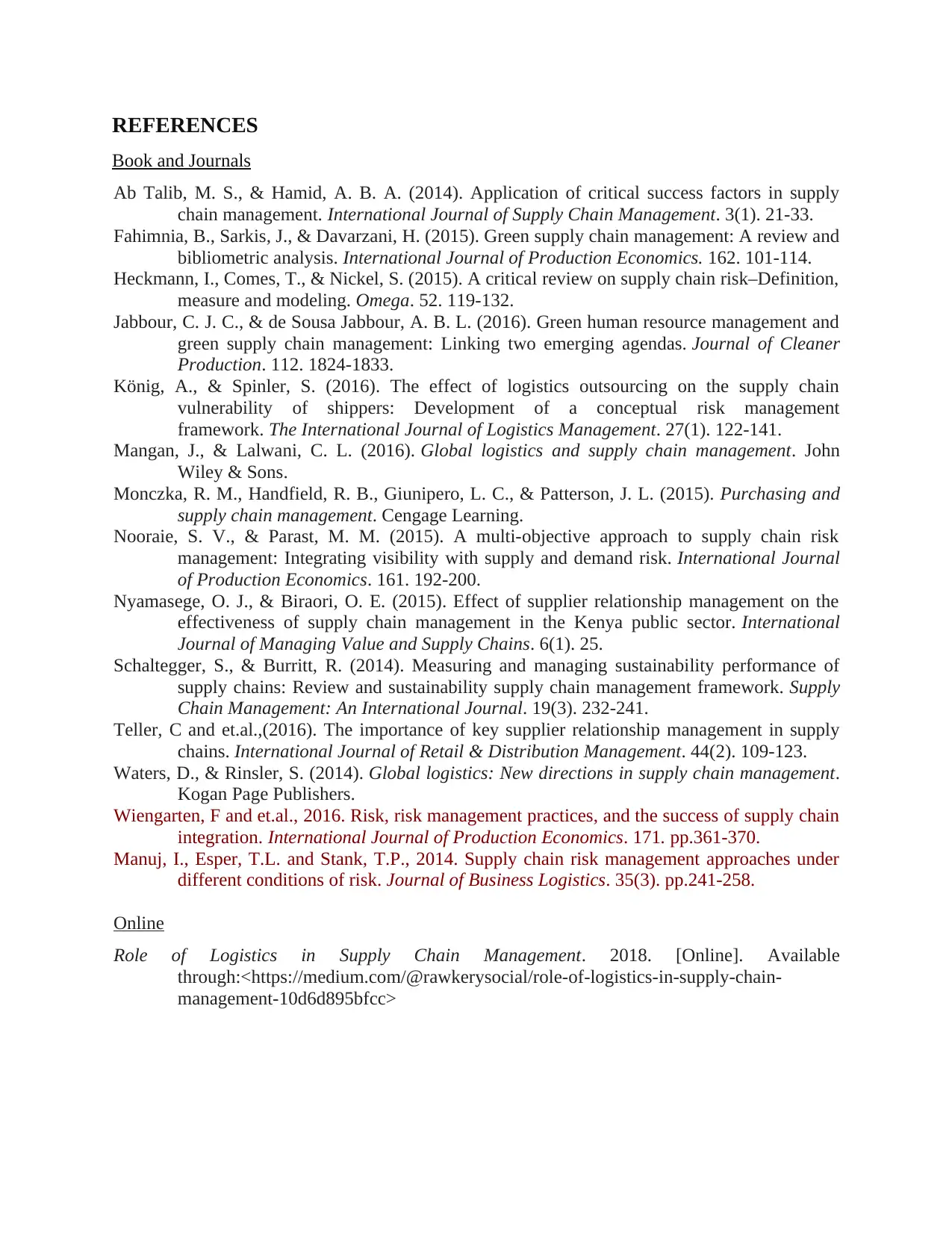
REFERENCES
Book and Journals
Ab Talib, M. S., & Hamid, A. B. A. (2014). Application of critical success factors in supply
chain management. International Journal of Supply Chain Management. 3(1). 21-33.
Fahimnia, B., Sarkis, J., & Davarzani, H. (2015). Green supply chain management: A review and
bibliometric analysis. International Journal of Production Economics. 162. 101-114.
Heckmann, I., Comes, T., & Nickel, S. (2015). A critical review on supply chain risk–Definition,
measure and modeling. Omega. 52. 119-132.
Jabbour, C. J. C., & de Sousa Jabbour, A. B. L. (2016). Green human resource management and
green supply chain management: Linking two emerging agendas. Journal of Cleaner
Production. 112. 1824-1833.
König, A., & Spinler, S. (2016). The effect of logistics outsourcing on the supply chain
vulnerability of shippers: Development of a conceptual risk management
framework. The International Journal of Logistics Management. 27(1). 122-141.
Mangan, J., & Lalwani, C. L. (2016). Global logistics and supply chain management. John
Wiley & Sons.
Monczka, R. M., Handfield, R. B., Giunipero, L. C., & Patterson, J. L. (2015). Purchasing and
supply chain management. Cengage Learning.
Nooraie, S. V., & Parast, M. M. (2015). A multi-objective approach to supply chain risk
management: Integrating visibility with supply and demand risk. International Journal
of Production Economics. 161. 192-200.
Nyamasege, O. J., & Biraori, O. E. (2015). Effect of supplier relationship management on the
effectiveness of supply chain management in the Kenya public sector. International
Journal of Managing Value and Supply Chains. 6(1). 25.
Schaltegger, S., & Burritt, R. (2014). Measuring and managing sustainability performance of
supply chains: Review and sustainability supply chain management framework. Supply
Chain Management: An International Journal. 19(3). 232-241.
Teller, C and et.al.,(2016). The importance of key supplier relationship management in supply
chains. International Journal of Retail & Distribution Management. 44(2). 109-123.
Waters, D., & Rinsler, S. (2014). Global logistics: New directions in supply chain management.
Kogan Page Publishers.
Wiengarten, F and et.al., 2016. Risk, risk management practices, and the success of supply chain
integration. International Journal of Production Economics. 171. pp.361-370.
Manuj, I., Esper, T.L. and Stank, T.P., 2014. Supply chain risk management approaches under
different conditions of risk. Journal of Business Logistics. 35(3). pp.241-258.
Online
Role of Logistics in Supply Chain Management. 2018. [Online]. Available
through:<https://medium.com/@rawkerysocial/role-of-logistics-in-supply-chain-
management-10d6d895bfcc>
Book and Journals
Ab Talib, M. S., & Hamid, A. B. A. (2014). Application of critical success factors in supply
chain management. International Journal of Supply Chain Management. 3(1). 21-33.
Fahimnia, B., Sarkis, J., & Davarzani, H. (2015). Green supply chain management: A review and
bibliometric analysis. International Journal of Production Economics. 162. 101-114.
Heckmann, I., Comes, T., & Nickel, S. (2015). A critical review on supply chain risk–Definition,
measure and modeling. Omega. 52. 119-132.
Jabbour, C. J. C., & de Sousa Jabbour, A. B. L. (2016). Green human resource management and
green supply chain management: Linking two emerging agendas. Journal of Cleaner
Production. 112. 1824-1833.
König, A., & Spinler, S. (2016). The effect of logistics outsourcing on the supply chain
vulnerability of shippers: Development of a conceptual risk management
framework. The International Journal of Logistics Management. 27(1). 122-141.
Mangan, J., & Lalwani, C. L. (2016). Global logistics and supply chain management. John
Wiley & Sons.
Monczka, R. M., Handfield, R. B., Giunipero, L. C., & Patterson, J. L. (2015). Purchasing and
supply chain management. Cengage Learning.
Nooraie, S. V., & Parast, M. M. (2015). A multi-objective approach to supply chain risk
management: Integrating visibility with supply and demand risk. International Journal
of Production Economics. 161. 192-200.
Nyamasege, O. J., & Biraori, O. E. (2015). Effect of supplier relationship management on the
effectiveness of supply chain management in the Kenya public sector. International
Journal of Managing Value and Supply Chains. 6(1). 25.
Schaltegger, S., & Burritt, R. (2014). Measuring and managing sustainability performance of
supply chains: Review and sustainability supply chain management framework. Supply
Chain Management: An International Journal. 19(3). 232-241.
Teller, C and et.al.,(2016). The importance of key supplier relationship management in supply
chains. International Journal of Retail & Distribution Management. 44(2). 109-123.
Waters, D., & Rinsler, S. (2014). Global logistics: New directions in supply chain management.
Kogan Page Publishers.
Wiengarten, F and et.al., 2016. Risk, risk management practices, and the success of supply chain
integration. International Journal of Production Economics. 171. pp.361-370.
Manuj, I., Esper, T.L. and Stank, T.P., 2014. Supply chain risk management approaches under
different conditions of risk. Journal of Business Logistics. 35(3). pp.241-258.
Online
Role of Logistics in Supply Chain Management. 2018. [Online]. Available
through:<https://medium.com/@rawkerysocial/role-of-logistics-in-supply-chain-
management-10d6d895bfcc>
1 out of 11
Related Documents
Your All-in-One AI-Powered Toolkit for Academic Success.
+13062052269
info@desklib.com
Available 24*7 on WhatsApp / Email
![[object Object]](/_next/static/media/star-bottom.7253800d.svg)
Unlock your academic potential
Copyright © 2020–2025 A2Z Services. All Rights Reserved. Developed and managed by ZUCOL.





